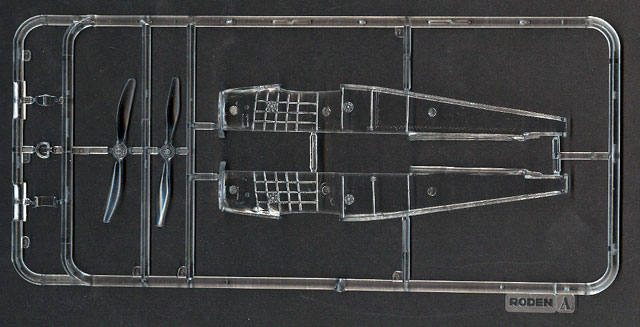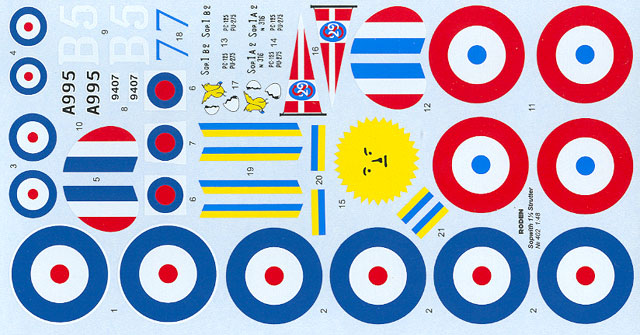S u m m a r y
|
| Catalogue
Number: |
RD402 |
| Scale: |
1/48 |
| Contents and Media: |
10 parts in clear styrene; 58
parts in light grey styrene; 1x photo-etched fret; four marking
options. |
| Price: |
USD$20.96 from Squadron.com |
| Review Type: |
First Look |
| Advantages: |
Nice surface texture; excellent
small details (brass and plastic); significant subject; plentiful
marking options; well thought-out engineering (e.g. placement of sprue
connectors on fuselage); great to see a 1/48 scale companion company
to Eduard in the WWI mainstream market |
| Disadvantages: |
Clear fuselage and wings is a
creditable but probably misguided idea; no locating pins on main
parts; some potential fit problems - builder beware! |
| Recommendation: |
Recommended |
Reviewed by Brett Green

Roden's 1/48
Scale Sopwith 1½ Strutter is available online from Squadron.com
HyperScale's resident WWI guru, Rob Baumgartner, has reviewed most of
Roden's 1/72 scale WWI kits over the last 18 months. His recurring themes
are that Roden's kits are well-researched and accurate, have very good
fine detail, include imaginative markings and are well engineered; but on
the other hand they are tricky to build and fine parts are susceptible to
damage.
I will leave the question of accuracy to Rob (this kit and its
companion bomber version are already winging their way to Perth), but my
overall impressions of this premiere 1/48 scale Roden release are the same
as Rob's opinion of the 1/72 scale kits.
I was delighted to see that Roden had expanded into 1/48 scale. The
subject matter was also a cause for celebration. The Sopwith 1½ Strutter
was an historically significant and widely used aircraft that deserves a
good quality injection moulded kit in this scale.
The first impression on opening the box is the clear sprues for the
fuselage halves, wings (including alternate top wing), tail surfaces,
cockpit decking and propeller blades.

Click the thumbnails below
to view larger images:
The theory behind this initiative is that the modeller can paint
structural details with a solid black paint or permanent marker, then
apply a translucent coat of colour over the top. This is a nice idea but
might be more difficult to achieve than it sounds. It will also require a
putty-free construction job to obtain a perfect finish. Clear plastic will
also complicate construction as it is more brittle than standard coloured
styrene. Nevertheless, the modeller can choose to treat the clear plastic
like any other plastic if he wishes.
Apart from the clear styrene, the main parts are very well moulded with
fine surface detail including stitching and subtly raised ribs. The
trailing edges of the wings are also admirably thin. Sprue attachment
points are located thoughtfully away from areas that will show up on the
final model, especially on the fuselage halves. Even if the clear styrene
is not given the translucent paintjob, it will be easier to mask the clear
windows in the top wing than to cleanly glue in a clear insert.
There are no locating pins on any of the main parts, so a little extra
time will be required for test-fitting and securing the sub-assemblies
while setting.
The remaining styrene parts are beautifully moulded. There are no
sinkmarks or ejector pin marks in visible positions, but a little flash
will need to be dealt with. The struts are scale thickness and will
therefore require careful removal from sprues and subsequent handling. The
detail parts include a total of six .303 Vickers and Lewis guns (labelled
"Levis" guns in the instructions). These are wonderful mouldings. It will
be very nice to have four of these guns in the spares box!
A photo-etched fret is also included. This fret contains an instrument
panel, control surface actuators and other details.
Click the thumbnails below
to view larger images:
A nice large decal sheet includes markings for two British and two
French aircraft.

Instructions are called out over ten steps using exploded view
diagrams. However, the steps seem to be randomly scattered over the pages
of the little instruction booklet. It is not too hard to follow though.
Colour callouts are provided using stock numbers from the Humbrol enamel
range.
Roden's 1/48 scale Sopwith 1½ Strutter looks brilliant in
the box but it should still be treated as a limited-run kit. I have heard
from several modellers who have already built or started this kit that
there are several challenges in the construction.
The most effective remedy is to follow the three Golden
Rules of Modelling:
-
Test Fit
-
Test Fit
-
Test Fit
If this is Roden's first foray into 1/48 scale, I
can't wait to see how they continue to develop and improve over the next
few years!
Recommended.
Thanks to
Squadron.com for the review sample.
Review and Images Copyright © 2002 by
Brett Green
Page Created 02 November, 2002
Last updated 22 July, 2003
Back to HyperScale Main Page
Back to Reviews Page
|
Home | What's
New | Features
| Gallery |
Reviews | Reference
| Forum
| Search